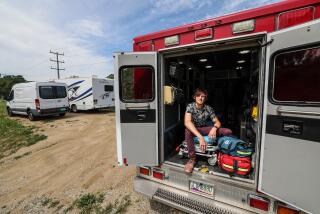$3,660 for a four-mile ride? Ambulances are hitting patients with surprise bills
- Share via
One patient got a $3,660 bill for a four-mile ride. Another was charged $8,460 for a trip from one hospital that could not handle his case to another that could. Still another found herself marooned at an out-of-network hospital, where she’d been taken by ambulance without her consent.
These patients all took ambulances in emergencies and got slammed with unexpected bills.
Public outrage has erupted over surprise medical bills — generally out-of-network charges that a patient did not expect or could not control — prompting 21 states to pass laws protecting consumers in some situations. But these laws largely ignore ground ambulance rides, which can leave patients stuck with hundreds or even thousands of dollars in bills, with few options for recourse, finds a Kaiser Health News review of 350 consumer complaints in 32 states.
Patients usually choose to go to the doctor, but they are vulnerable when they call 911 — or get into an ambulance. The dispatcher picks the ambulance crew, which, in turn, often picks the hospital. Moreover, many ambulances are not summoned by patients. Instead, the crew arrives at the scene because police or a bystander called 911.
Betsy Imholz, special projects director at the Consumers Union, which has collected over 700 patient stories about surprise medical bills, said at least a quarter of the stories concern ambulances.
“It’s a huge problem,” she said.
In July, a California law went into effect that protects consumers from surprise medical bills from out-of-network providers, including some ambulance transport between hospitals. But most people with private insurance are not covered by the law and some patients are still fighting cases that happened before it went into effect.
No state laws with surprise-billing protections apply to people with self-funded employer-sponsored health insurance plans, which are regulated only by federal law. That’s a huge exception: 61% of privately insured employees are covered by self-funded employer-sponsored plans.
Forty years ago, most ambulances were free for patients, provided by volunteers or town fire departments using taxpayer money, said Jay Fitch, president of Fitch & Associates, an emergency services consulting firm. Today, ambulances are increasingly run by private companies and venture capital firms.
Ambulance providers now often charge by the mile and sometimes for each “service,” like providing oxygen. If the ambulance is staffed by paramedics rather than emergency medical technicians, that will result in a higher charge — even if the patient didn’t need paramedic-level services. Charges range widely from zero to thousands of dollars, depending on billing practices.
The core of the problem is that ambulance and private insurance companies often can’t agree on a fair price, so the ambulance service doesn’t join the insurance network. That leaves patients stuck in the middle with out-of-network charges that are not negotiated, Imholz said.
This happens to patients frequently, according to one recent study of over half a million ambulance trips taken by patients with private insurance in 2014. The study found that 26% of these trips were billed on an out-of-network basis.
That figure is “quite jarring,” said Loren Adler, associate director for the USC-Brookings Schaeffer Initiative and co-author of recent research on surprise billing.
Kaiser Health News’ review of complaints revealed two common scenarios leaving patients in debt: First, patients get in an ambulance after a 911 call. Second, an ambulance transfers them between hospitals. In both scenarios, patients later learn the fee is much higher because the ambulance was out-of-network, and after their insurer pays what it deems fair, they get a surprise bill for the balance, also known as a “balance bill.”
Most complaints reviewed by Kaiser Health News did not appear to involve fraudulent charges. Instead, patients got caught in a system in which ambulance services can legally charge thousands of dollars for a single trip — even when the trip starts at an in-network hospital.
That’s what happened to Devin Hall, a 67-year-old retired postal inspector in Northern California. While he faces stage 3 prostate cancer, Hall is also fighting a $7,109.70 out-of-network ambulance bill from American Medical Response, the nation’s largest ambulance provider.
On Dec. 27, 2016, Hall went to a local hospital with rectal bleeding. Since the hospital didn’t have the right specialist to treat his symptoms, it arranged for an ambulance ride to another hospital about 20 miles away. Even though the hospital was in-network, the ambulance was not.
Hall was stunned to see that AMR billed $8,460 for the trip. His federal health plan, the Special Agents Mutual Benefit Assn., paid $1,350.30 and held Hall responsible for $727.08, records show. The health plan paid that amount because AMR’s charges exceeded its Medicare-based fee schedule, according to its explanation of benefits. But AMR turned over his case to a debt collector, Credence Resource Management, which sent an Aug. 25 notice seeking the full balance of $7,109.70.
“These charges are exorbitant — I just don’t think what AMR is doing is right,” said Hall, noting that he had intentionally sought treatment at an in-network hospital.
He has spent months on the phone calling the hospital, his insurer and AMR trying to resolve the matter. After being contacted by Kaiser Health News, AMR said it has pulled Hall’s case from collections while it reviews the billing.
After further review, company spokesman Jason Sorrick said the charges were warranted because it was a “critical care transport, which requires a specialized nurse and equipment on board.” Sorrick faulted Hall’s health plan for underpaying, and said Hall could receive a discount if he qualifies for AMR’s “compassionate care program” based on his financial and medical situation.
“In this case, it appears the patient’s insurance company simply made up a price they wanted to pay,” Sorrick said.
While the federal government sets reimbursement rates for patients on Medicare, it does not regulate ambulance fees for patients with private insurance. In the absence of federal rules, those patients are left with a fragmented system in which the cost of a similar ambulance ride can vary widely from town to town. There are about 14,000 ambulance services across the country, run by governments, volunteers, hospitals and private companies, according to the American Ambulance Assn.
Peter Racicot, senior vice president of Fallon Ambulance Service, a family-owned company based outside Boston, said ambulance companies are “severely underfunded” by Medicare and Medicaid. Fallon must balance the books by charging higher rates for patients with private insurance, he said.
When insurers and ambulance companies can’t agree on a fair rate, Racicot said, “unfortunately, the subscribers wind up in the middle.”
Ambulance services have to charge enough to subsidize the cost of keeping crews ready around-the-clock even if no calls come in, said Fitch, the ambulance consultant. In a third of the cases where an ambulance crew answers a call, he added, they end up not transporting anyone and the company typically isn’t reimbursed for the trip.
The consumer complaints reviewed by Kaiser Health News reveal a wide variety of ways that patients are left fighting big bills:
- An older patient in California said debt collectors called incessantly, including on Sunday mornings and at night, demanding an extra $500 on top of the $1,000 that his insurance had paid for an ambulance trip.
- Two ambulance services responded to a New Jersey man’s 911 call when he felt burning in his chest. One charged him $2,100 for treating him on the scene for less than 30 minutes — even though he never rode in that company’s ambulance.
- A woman who rolled over in her Jeep in Texas received a bill for a $26,400 “trauma activation fee” — a fee triggered when the ambulance service called ahead to the emergency department to assemble a trauma team. The woman, who did not require trauma care, fought the hospital to get the fee waived.
Patients do have the right to refuse an ambulance ride, as long as they are over 18 and mentally capable.
“You could just take an Uber,” said Adler, of the Schaeffer Initiative. But if you need an ambulance, there’s little recourse to avoid surprise bills, he said, “other than yelling at the insurance company after the fact, or yelling at the ambulance company.”
This article was prepared for Kaiser Health News, an editorially independent publication of the Kaiser Family Foundation. Kaiser Health News correspondent Chad Terhune contributed to this report.
Twitter: @mmbaily and @chadterhune
More to Read
Inside the business of entertainment
The Wide Shot brings you news, analysis and insights on everything from streaming wars to production — and what it all means for the future.
You may occasionally receive promotional content from the Los Angeles Times.










